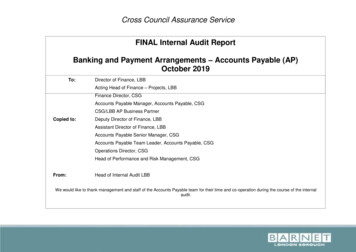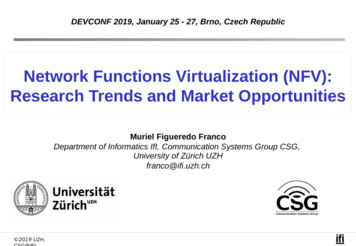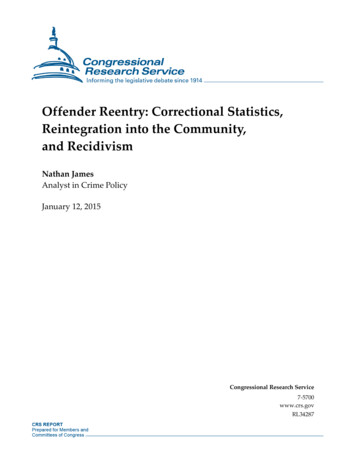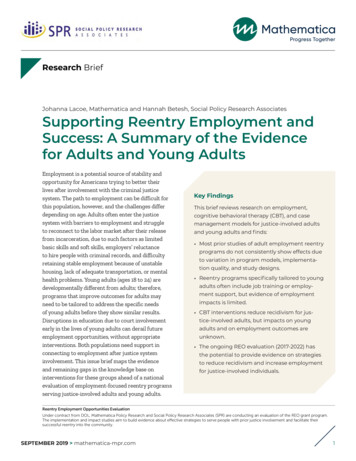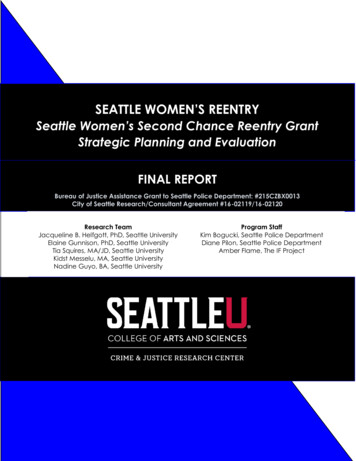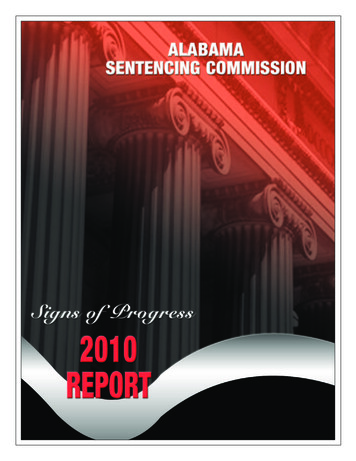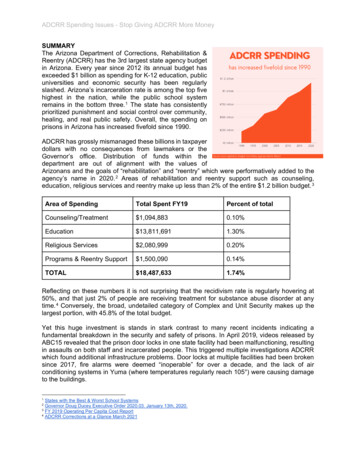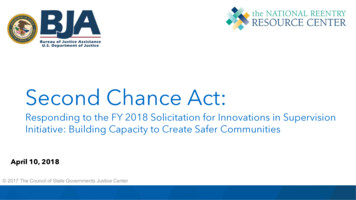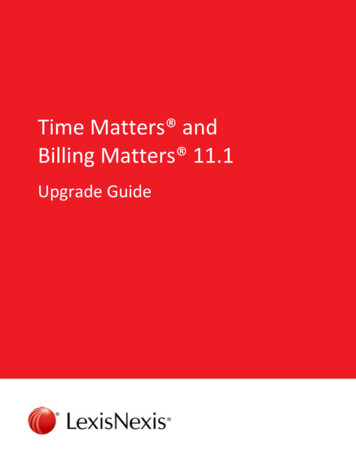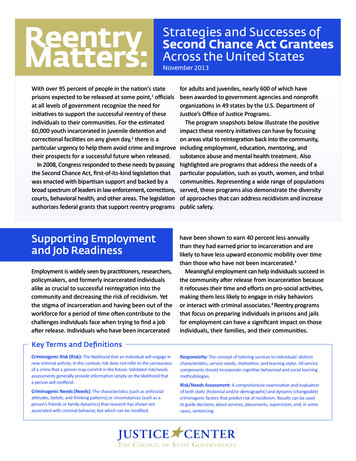
Transcription
ReentryMatters:Strategies and Successes ofSecond Chance Act GranteesAcross the United StatesNovember 2013With over 95 percent of people in the nation’s stateprisons expected to be released at some point,1 officialsat all levels of government recognize the need forinitiatives to support the successful reentry of theseindividuals to their communities. For the estimated60,000 youth incarcerated in juvenile detention andcorrectional facilities on any given day,2 there is aparticular urgency to help them avoid crime and improvetheir prospects for a successful future when released.In 2008, Congress responded to these needs by passingthe Second Chance Act, first-of-its-kind legislation thatwas enacted with bipartisan support and backed by abroad spectrum of leaders in law enforcement, corrections,courts, behavioral health, and other areas. The legislationauthorizes federal grants that support reentry programsfor adults and juveniles, nearly 600 of which havebeen awarded to government agencies and nonprofitorganizations in 49 states by the U.S. Department ofJustice’s Office of Justice Programs.The program snapshots below illustrate the positiveimpact these reentry initiatives can have by focusingon areas vital to reintegration back into the community,including employment, education, mentoring, andsubstance abuse and mental health treatment. Alsohighlighted are programs that address the needs of aparticular population, such as youth, women, and tribalcommunities. Representing a wide range of populationsserved, these programs also demonstrate the diversityof approaches that can address recidivism and increasepublic safety.Supporting Employmentand Job Readinesshave been shown to earn 40 percent less annuallythan they had earned prior to incarceration and arelikely to have less upward economic mobility over timethan those who have not been incarcerated.3Meaningful employment can help individuals succeed inthe community after release from incarceration becauseit refocuses their time and efforts on pro-social activities,making them less likely to engage in risky behaviorsor interact with criminal associates.4 Reentry programsthat focus on preparing individuals in prisons and jailsfor employment can have a significant impact on thoseindividuals, their families, and their communities.Employment is widely seen by practitioners, researchers,policymakers, and formerly incarcerated individualsalike as crucial to successful reintegration into thecommunity and decreasing the risk of recidivism. Yetthe stigma of incarceration and having been out of theworkforce for a period of time often contribute to thechallenges individuals face when trying to find a jobafter release. Individuals who have been incarceratedKey Terms and DefinitionsCriminogenic Risk (Risk): The likelihood that an individual will engage innew criminal activity. In this context, risk does not refer to the seriousnessof a crime that a person may commit in the future. Validated risk/needsassessments generally provide information simply on the likelihood thata person will reoffend.Criminogenic Needs (Needs): The characteristics (such as antisocialattitudes, beliefs, and thinking patterns) or circumstances (such as aperson’s friends or family dynamics) that research has shown areassociated with criminal behavior, but which can be modified.Responsivity: The concept of tailoring services to individuals’ distinctcharacteristics, service needs, motivation, and learning styles. All servicecomponents should incorporate cognitive-behavioral and social learningmethodologies.Risk/Needs Assessment: A comprehensive examination and evaluationof both static (historical and/or demographic) and dynamic (changeable)criminogenic factors that predict risk of recidivism. Results can be usedto guide decisions about services, placements, supervision, and, in somecases, sentencing.
New York City Office of theCriminal Justice CoordinatorProgram: Harlem Parole ReentryCourt, New York, New YorkIn a reentry court program, judges, case managers, andcommunity supervision officers work in a collaborativeprocess to develop a reentry plan, assign services basedon an individual’s needs, and monitor compliance andsuccess. A project of the Center for Court Innovation,the Harlem Parole Reentry Court was established in2001 and serves adult men and women who areassessed to be at medium to high risk of reoffendingand are returning to New York City’s East and CentralHarlem neighborhoods from correctional facilities inthe state.Key features of the Harlem Parole Reentry Courtinclude an emphasis on job readiness and employmentto promote self-sufficiency and accountability; use of arisk assessment tool to determine individuals’ risk levelsand needs; cognitive-behavioral therapy to help shiftcriminal thinking and behavior; and the use of graduatedsanctions and incentives to respond promptly andproportionately to both violations of and compliance withthe conditions of supervision. The program also celebratesand reinforces achievements through graduationceremonies in which participants can demonstrateto their families and community the positive changesthey have made.5 A newer aspect of the program isproviding support for families of young adults, ages 18to 26, who are on parole, beginning pre-release andcontinuing through the first nine months after release.About one-third of participants wereemployed 12 months after release, comparedto only a quarter of a group of similarindividuals who were on parole but did notparticipate in the reentry court. Additionally,more reentry court participants wereemployed full-time than in the comparisongroup (25 percent vs. 19.8 percent).6The reincarceration rate 12 months afterrelease was 14.7 percent for programparticipants, compared to 19.3 percentfor the comparison group.7Graduated Sanctions and IncentivesThe use of graduated sanctions and incentives is an evidence-basedpractice that allows for more options—particularly community-basedoptions—to respond to low-level violations, with the goal of holdingindividuals accountable for their actions. In fact, research has shown thatwhen penalizing a person for violating the conditions of his or her release,the immediate application of a sanction has a greater impact on preventingfuture criminal behavior than the severity of the sanction itself.8Graduated sanctions and incentives also have great potential for costsavings, as many jurisdictions have found community-based treatmentto be less expensive and more effective than incarceration or prison-2based treatments.9 Furthermore, diverting individuals who committedlower-level crimes to community-based programs can free up beds andresources for those incarcerated for more serious crimes.In the Harlem Parole Reentry Court, the range of possible sanctionsfor missed appointments with program staff, failed drug tests, andother misconduct includes curfews, an increased number of requiredcourt appearances, a period of confinement in a residential substanceabuse treatment facility, and, for the most serious cases, a return toprison. Compliant behavior may be reinforced with reduced courtreporting or a relaxation of travel restrictions.
Ottawa County, MichiganProgram: West Shoreline 2ndChance ConnectionsIn this program, participants receive case planning thatprepares them to reintegrate into their communities,reconnect with their families, and find employmentupon release from prison or jail. By serving individualsconvicted of felonies who have been assessed as atmedium and high risk of reoffending, the programapplies resources that maximize the impact on recidivism.A core objective of the program is to prepareindividuals on parole or probation and are parentsof minor children to get jobs and provide for theirfamilies. The program provides training in the “soft skills” necessary for long-termemployment, such as communication and problemsolving.The program is a collaborative project of OttawaCounty; Muskegon Community College; the MichiganDepartment of Corrections; and community-basedorganizations, including 70x7 Life Recovery, GoodwillIndustries, Mediation & Restorative Services, andPathways, MI. Program administrators have also builtstrong partnerships with employers in the communityto increase participants’ job opportunities.West Shoreline 2nd ChanceConnections Program Graduates10 a 13-week transitional employment initiative in whichparticipants receive the classroom-based and handson training necessary to prepare for a career in themanufacturing industry, followed by temporary,structured, and subsidized employment; and“Our journey of hiring ex-offenders began over a decade ago. I had juststarted our business, and a guy came in looking for a job who said hehad recently been released from prison. I was desperate for more helpat the time and appreciated his honesty, so I hired him on the spot.David* has been with us for over 12 years now and is one of our bestemployees.About five years ago, we decided to take on a fellow named Jeffthrough 70x7 Life Recovery’s staffing agency. Like David, Jeff showeda real appreciation just to be working, and he had a great attitude.At one point, a car manufacturer had problems with an accelerator pedal sticking and urgentlyneeded us to make a large quantity of a single part in order to fix the problem. Working with meon a Sunday night, Jeff shared with me how great it was to be working and earning money, payingtaxes, and, by making this automotive part, being able to possibly prevent someone from gettinghurt or killed. This is when I knew we were doing the right thing.We now have 10 employees who were formerly incarcerated and are now able to support theirfamilies, supply them with health insurance, and restore their own dignity. Every one of theseguys has a key to the door of our business. I trust them with my livelihood and, in turn, theyare a great bunch of dedicated, hardworking employees. Being a small part of their successmakes my wife Carin and I feel very blessed.”— Andy Ribbens, President of Premier Finishing, Inc., Walker, MI* Names of employees have been changed.3
Building StrongFoundations ThroughEducationContributing to the challenges involved in reentry is thefact that individuals in the criminal justice system oftenhave had limited education. A Bureau of Justice Statisticsstudy found that the majority of individuals incarcerated instate prisons lack a high school diploma or its equivalent.11Because education is strongly tied to a person’semployment opportunities, financial stability, and qualityof life, providing educational and vocational programs toadults and youth during incarceration is critical. A recentstudy by the RAND Corporation found that, on average,individuals who participated in correctional educationprograms were 43 percent less likely to recidivate uponrelease than those who had not participated.12 In addition,connecting individuals to these programs when theyreturn to their communities after incarceration can setthem on the path to obtaining employment and havingthe tools they need to succeed upon their release.City of Oakland, California –Department of HumanServicesProgram: Comprehensive CommunityCross-System Reentry Support(C3RS) ProjectIn the C3RS Project, government and nonprofitpartners work together to reduce recidivism among4youth (ages 13 to 18) who are returning to Oaklandfrom a juvenile detention facility. A collaborativeprocess informs each activity, including communitybased case management, multidisciplinary teammeetings, cross-systems training, data sharing andcollection, and addressing needs of the youths’families. These young people receive a number ofassessments to identify risk levels, key criminogenicneeds, and mental health needs, all of which informtheir case plans. Each of the youth is assigned acommunity-based case manager who meets withthem both pre- and post-release.A strong element of the program is its focus onre-engaging the youth in school upon their release.Through the program, school representatives arenow located directly at the Alameda County JuvenileJustice Center, which has greatly improved andexpedited the school placement process for youthexiting the detention facility.This unique partnership includes the City ofOakland Department of Human Services; AlamedaCounty Health Care Services; Alameda CountyProbation; Oakland Unified School District; communitybased case management agencies including East BayAsian Youth Center, East Bay Agency for Children, TheMentoring Center, California Youth Outreach, andYouth UpRising; and Bay Area Legal Aid, a legaladvocacy organization.In the first year of the program, of the592 participants, 442 (74.4 percent) werereenrolled in school. Of the 161 whoreceived job training, 102 (63.4 percent)were placed in jobs.Approximately 98 percent of Oaklandyouth are currently placed in the OaklandUnified School District within three daysof their release, compared to three yearsago when the average time for schoolplacement was at least eight days.
Fostering PositiveRelationships andFacilitating Servicesthrough MentoringYouth mentoring programs have long been establishedacross the country, as research has found that youth whohave at least one meaningful, caring relationship withan adult are twice as likely as youth without a meaningfuladult relationship to have healthy family and socialrelationships, to be financially self-sufficient, and to beengaged in their communities.13 For youth involved inthe juvenile justice system, the need for positive rolemodels and pro-social activities is even greater.The concept of mentoring as a means of support andguidance is increasingly applied with adults involved inthe criminal justice system. While it is difficult to measurethe impact of interpersonal relationships on behavior, itis believed that mentors can provide important supportduring the transition from incarceration to the community.Mentoring services can also help a program applyresponsivity principles. A mentor can address anindividual’s low motivation or unpreparedness forchange, enhance pro-social thinking and behaviorthrough modeling, and engage the program participantin substance abuse or mental health treatment,education, or family-based support services.Of the people who participated in NHRI’sstep-down process, 81 percent successfullycompleted the program, compared to just63 percent of those who did not participate.Connecticut Departmentof CorrectionProgram: New Haven ReentryInitiativeThrough the Connecticut Department of Correction’sNew Haven Reentry Initiative (NHRI), the New HavenCorrectional Center serves as a “step-down” facilityfrom the prison to the community. Beginning beforerelease, a step-down approach provides incarceratedindividuals with a continuum of care to prepare forchallenges upon their return and help increase thelikelihood that they will not reoffend. While at thefacility, participants are escorted on programfurloughs, or temporary releases, to address areasof need identified in their reentry plans. Furloughactivities may include community-based treatment,meetings with potential employers, educationalprograms, or 12-step program meetings. As of March2013, NHRI had enrolled 296 participants.NHRI is involved in a number of activities thatpromote collaboration and information sharingacross agencies to support reentry. The program’smain partners are Easter Seals Goodwill Industries,a community-based service provider, and FamilyReEntry, Inc., which is contracted to manage theinitiative. NHRI staff also participate in two regularcommunity events: bi-weekly meet-and-greet panelsfor individuals newly released to New Haven,a project of the city’s Parole, Adult Probation, andPolice Departments; and monthly Reentry Roundtablemeetings, which are attended by representativesfrom government agencies and community-basedorganizations, elected officials, and formerlyincarcerated individuals and their families. Theinitiative also draws on the valuable support of“community advocates,” individuals who havebeen incarcerated and were able to sustain positivechanges in their lives after their release. Teamedwith case managers, the advocates serve as rolemodels and have been an invaluable asset in theintensive case management model, particularlyreconnecting individuals with the services theyrequire after a lapse in participation.5
“I have been a Community Advocate for Easter Seals GoodwillIndustries for two and a half years, supporting and mentoringex-offenders returning home through the New Haven ReentryInitiative funded by the Connecticut Department of Correction.I went to jail at the age of 19 and served 20 years on a 30-year sentence.The turning point for me came during year 12, when I had a life-changing conversation with aperson serving a life sentence who encouraged me to improve myself and utilize my leadershipabilities for good. I earned my GED, enrolled in college courses, and got a job. I began facilitatinggroups to help others and became a positive force on the inside, so it was only natural for me totransition upon my release to my current role working with youth and adult ex-offenders.I do presentations to potential NHRI participants inside the prisons, addressing realisticexpectations and the supportive benefits to enrolling into this program. I explain to the menthat what they put into the program is what they will get out of it. I encourage them to be honestwith themselves regarding the serious issues—for example, domestic violence, substance abuse,anger and mental health issues—that typically lead to reincarceration. We get participants to behonest and truthful about the deep-rooted issues, which is why this program is so effective.The Reentry Initiative has earned strong street credibility within the City of New Haven dueto the sincerity of staff and the opportunities that the program creates, which are differentfrom so many existing programs.”—William Outlaw, Jr., Community Advocate,Easter Seals Goodwill Industries, New Haven, CTRoca, Inc.Program: Springfield CommunityMentoring Project, Springfield,MassachusettsRoca, Inc. coordinates mentoring services for youngadult males, ages 18 to 24, who are involved with gangsand have substance abuse needs. The program trainsthree types of mentors: volunteers who provide oneto-one mentoring and group-based support, staff casemanagers, and workplace mentors. Mentors meetwith participants in the correctional facility beforetheir release, enabling the mentors to develop strongrelationships with their mentees. By offering differenttypes of mentor relationships and approaches, theprogram engages participants on a number of levels andaddresses multiple needs. The program’s emphasis onemployment helps young men focus on building asustainable future away from gang and criminal activity.6Roca works in partnership with the Superior and DistrictCourts’ Probation Office, the Hampden County Sheriff’sDepartment, and the Massachusetts Department of YouthServices—relationships that are critical to meeting theneeds of high-risk youth in the Springfield area.The Social Impact Exchange recentlynamed Roca as one of the top 100 nonprofits in the country for social impact forits youth intervention model. In addition,the organization will be the lead providerin the Massachusetts Juvenile JusticeSocial Innovation Financing pilot project,which employs a partnership betweengovernment, philanthropic, and privateinvestors to fund social services andmaximize impact.
Addressing SubstanceAbuse and Mental HealthNeedsSubstance abuse and mental illness are significantissues among incarcerated individuals. The majorityof people in prisons and jails meet criteria forsubstance dependence or abuse,14 and a 2009study of jail populations found 16.9 percent of thepopulation to have a serious mental illness—threeto six times the rate for the general population.15Moreover, these populations often overlap, withindividuals who have co-occurring substance abuseand mental health disorders representing up to 11percent of the prison population.16Most of these individuals with substance abuseand/or mental health needs are released fromincarceration without receiving the treatment theyneed, and a large number return to the criminaljustice system. Addressing these needs before andafter release from incarceration is crucial in promotingrecovery and increasing the likelihood they will avoidcriminal behavior and stay out of prison or jail.Minnesota Departmentof CorrectionsProgram: Co-occurring Programat Minnesota CorrectionalFacility-Lino LakesThis program provides evidence-based, integratedtreatment to adults with co-occurring substance abuseand mental health disorders returning to communitiesacross the state. By integrating treatment, the programaddresses substance abuse and mental health needs intandem, rather than through separate systems, ensuringthat services support one another and produce the bestpossible outcomes for the individual. The programuses risk and needs assessments to prioritize high-riskand high-need individuals.Program administrators work closely with communitybased service providers in a process wherein programparticipants and multidisciplinary teams—made upof mental health providers, community supervisionagents, community treatment and service providers,and family members—work together to develop arelease plan and ensure continuity of care during thetransition period. Participants enter the program 6 to12 months pre-release and continue 6 months afterrelease. In addition to treatment, program componentsinclude educational programming;mental health and substance abuse treatment;other cognitive-behavioral treatment interventions;motivational interviewing;pro-social skills development;employment and job readiness services; andreferrals to housing.In partnership with the Minnesota NationalAlliance for the Mentally Ill, the MinnesotaDepartment of Corrections has hostedtwo forums on co-occurring disorders thatfocused on collaborative planning, resultingin new efforts in the state to improve servicedelivery for individuals with co-occurringdisorders returning to the community afterincarceration. Represented in the forumsand subsequent working groups were stateand local government agencies, communitybased treatment providers, correctionaladministrators, community correctionsagencies, clients, and their families.7
Supporting Youth toAvert Future Involvementin the Criminal JusticeSystemWhile the number of youth in juvenile detentionand correctional facilities has declined significantlyin recent years, there are still approximately 60,000youth in residential facilities on any given day in theUnited States. Many of these young people strugglewith challenges such as low levels of education,substance abuse and mental health issues, housinginstability, and past trauma. Communities have aunique opportunity and responsibility to ensurethat these youth are given the chance to overcomebarriers to success, avoid crime, and ultimatelythrive.Ohio Department ofYouth ServicesThe Ohio Department of Youth Services (Ohio DYS)partners with three community-based organizationsto offer mentoring and supportive services for youthwho are returning from juvenile detention facilities toone of five counties in the state. Services begin sixmonths prior to release and continue for a minimumof six months after release. Mentors maintain regularcommunication with their mentee’s parole officer,social worker, and family to help ensure that theyouth receive comprehensive, individualized servicesin the community.The program employs three mentoring modelsto accommodate the varying security classificationlevels and criminogenic risk levels of the youth whoare served: one-to-one mentoring, group mentoring,and peer mentoring, which incorporates young adultmentors for youth who may respond better toreinforcement from individuals closer to their age. Ofprogram participants on parole in the first year of theprogram, 76 percent have maintained their mentoringrelationship after returning to their communities.178Texas Juvenile JusticeDepartmentProgram: Gang InterventionTreatment: Reentry Developmentfor Youth (GitRedy), Harris County,TexasThe Texas Juvenile Justice Department’s GitRedyprogram provides family-focused reentry services togang-affiliated youth, ages 13 to 19, who are returningto Harris County from the department’s correctionalinstitutions. Based on assessments at intake, the agencyoffers comprehensive case management and a rangeof services based on the individual needs of each youth.Every 30 days, case plans reviewed by a collaborative,multidisciplinary team of practitioners are updatedand revised, as needed. Reinforcing the collaboration,staff members receive training in the Systems of Caremodel, a comprehensive, cross-agency approach toproviding services to children and families. Servicesinclude evidence-based practices for youth such asAggression Replacement Training and FunctionalFamily Therapy, as well as medical treatment,educational programs, and vocational training.Of the Ohio DYS mentees on parole, 58percent are enrolled in school, and 35percent obtained their GED or high schooldiploma before leaving the detentionfacility.19
Addressing the DistinctNeeds of Women“When I signed up for this program I reallydid not think it would work for me. I felt thatI would always struggle, and to be truthfulI was afraid I would return to prison after ashort while. Here it is years later and not onlyam I able to keep a job and take care of myfamily, but I am currently learning how tostart my own business.”—Lyndsey*Project Reconnect participantGirl Scouts of Eastern OklahomaWomen involved with the criminal justice system havea distinct set of issues, including high rates of substanceabuse, mental health disorders, and victimization andpast trauma; low rates of employment and financialstability; and challenges in maintaining child custody.However, being a minority of the total prison populationat approximately 7 percent,20 women often find thatcorrectional and reentry programs are not tailoredwith their needs in mind. Reentry programs that focuson these needs will better assist women returning homefrom incarceration, as well as their children and families.Girl Scouts of EasternOklahomaProgram: Project Reconnect,Tulsa, OklahomaThe Girl Scouts of Eastern Oklahoma serves women whowill be returning to the Tulsa area after incarceration andhave children between the ages of 5 and 18. The programprovides them with services that allow them to maintaincontact with their children through bi-monthly visits inthe facility. Acknowledging that the commute to prisoncan be challenging or prohibitive for many families, theGirl Scouts of Oklahoma transports children for biweeklyvisits with their mothers in prison. On alternate weeks,the women take parenting classes, and their childrenreceive supplementary educational classes.A key component of Project Reconnect is its mentoringprogram, connecting the incarcerated mothers withvolunteer mentors to aid in the reentry process. Sincethe start of the grant project in October 2010, theorganization has trained 200 mentors.21 Additionally,the organization has forged partnerships with variousorganizations in the community—including faithbased groups, service organizations, and treatmentproviders—to support and provide reentry services.Of the 181 Project Reconnect participantswho have been in the community for atleast 12 months after release, only 4 (2.2percent) have recidivated.22Of the 125 individuals who participated inemployment development, 73 percent (92people) have obtained and maintained ajob. Of the 36 participants in the vocationalrehabilitation program, 72 percent (26people) have obtained and maintainedemployment.23Supporting the Strengthsand Needs of FamiliesIncarceration affects not only the high number ofindividuals in prisons and jails in the United States butalso their children and families. In 2007, an estimated1.7 million children under 18 had a parent in prison.24* Name has been changed.9
These children and other family members often facesignificant consequences from having a loved onein prison, such as financial difficulties, housinginstability, loss of emotional support and guidance,or social stigma. Children of incarcerated parentsare at increased risk of poor school performance,25substance use, and mental health problems.26At the same time, family support can be a key factorin successful reentry. Some research has shown thatpeople who regularly interact with their families whileincarcerated are more likely to succeed when returningto their community than those who do not.27 Manyreentry initiatives are addressing the needs of thechildren and families of incarcerated individuals,while building on the strengths of these networks tohelp support the individuals during incarceration andthrough the transition of returning home.Multnomah County, OregonProgram: Family Supports forTreatment and Reentry Success:Center for Family SuccessIn Multnomah County, treatment and family serviceproviders work with incarcerated individuals withsubstance abuse needs and their children andfamilies to assess their needs and provide appropriateservices. Targeting medium- to high-risk individualsfor the program, the providers use a continuum oftreatments and foster a smooth transition to servicesThis grant project enabled the county tocreate a unique internship opportunity foruniversity students, both graduate andundergraduate: interns act as “familyadvocates” who are paired with individualsat the time they enter the criminal justicesystem or reenter from incarceration tofacilitate the delivery of family engagementservices for the individuals and their families.10available in the community. The program operatesin collaboration with the Oregon Department ofCorrections and community-based service providers.Prior to release, incarcerated parents receiv
meetings, cross-systems training, data sharing and collection, and addressing needs of the youths' families. These young people receive a number of assessments to identify risk levels, key criminogenic needs, and mental health needs, all of which inform their case plans. Each of the youth is assigned a community-based case manager who meets with
